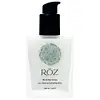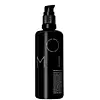What's inside
What's inside
 Key Ingredients
Key Ingredients

 Benefits
Benefits

 Concerns
Concerns

 Ingredients Side-by-side
Ingredients Side-by-side

Water
Skin ConditioningGlycerin
HumectantCetearyl Alcohol
EmollientCetyl Alcohol
EmollientCetrimonium Chloride
AntimicrobialPanthenol
Skin ConditioningFurcellaria Lumbricalis Extract
Skin ConditioningVaccinium Myrtillus Seed Oil
Skin ConditioningAmaranthus Caudatus Seed Extract
Skin ConditioningHydrolyzed Chestnut Extract
Skin ProtectingHydrolyzed Walnut Extract
AntioxidantHydroxyacetophenone
AntioxidantHelianthus Annuus Seed Oil
EmollientCaprylyl Glycol
Emollient1,2-Hexanediol
Skin ConditioningSodium Gluconate
Skin ConditioningHydroxypropyltrimonium Hyaluronate
Sodium Metabisulfite
AntioxidantTocopheryl Acetate
AntioxidantBisabolol
MaskingDiisostearyl Malate
EmollientLimonene
PerfumingVitis Vinifera Fruit Extract
Skin ConditioningGeraniol
PerfumingPhenethyl Alcohol
MaskingLinalool
PerfumingZingiber Officinale Root Extract
MaskingBoswellia Serrata Resin Extract
SmoothingHydroxycitronellal
PerfumingCitric Acid
BufferingRosmarinus Officinalis Leaf Extract
AntimicrobialSodium Benzoate
MaskingPotassium Sorbate
PreservativeParfum
MaskingWater, Glycerin, Cetearyl Alcohol, Cetyl Alcohol, Cetrimonium Chloride, Panthenol, Furcellaria Lumbricalis Extract, Vaccinium Myrtillus Seed Oil, Amaranthus Caudatus Seed Extract, Hydrolyzed Chestnut Extract, Hydrolyzed Walnut Extract, Hydroxyacetophenone, Helianthus Annuus Seed Oil, Caprylyl Glycol, 1,2-Hexanediol, Sodium Gluconate, Hydroxypropyltrimonium Hyaluronate, Sodium Metabisulfite, Tocopheryl Acetate, Bisabolol, Diisostearyl Malate, Limonene, Vitis Vinifera Fruit Extract, Geraniol, Phenethyl Alcohol, Linalool, Zingiber Officinale Root Extract, Boswellia Serrata Resin Extract, Hydroxycitronellal, Citric Acid, Rosmarinus Officinalis Leaf Extract, Sodium Benzoate, Potassium Sorbate, Parfum
Water
Skin ConditioningCetearyl Alcohol
EmollientDicaprylyl Carbonate
EmollientBehentrimonium Methosulfate
Yeast Extract
Skin ConditioningChitosan Succinamide
Cetyl Esters
EmollientHydrolyzed Sweet Almond Protein
Skin ConditioningPentaclethra Macroloba Seed Oil
EmollientButyrospermum Parkii Butter
Skin ConditioningCitrus Aurantium Bergamia Peel Oil
Lavandula Dentata Flower/Leaf Oil
MaskingZingiber Officinale Root Oil
MaskingSantalum Spicata Wood Oil
PerfumingDehydroacetic Acid
PreservativeLaurus Nobilis Leaf Oil
MaskingOlea Europaea Leaf Extract
PerfumingRosmarinus Officinalis Leaf Extract
AntimicrobialEugenia Caryophyllus Bud Oil
MaskingPogostemon Cablin Leaf Oil
MaskingSodium PCA
HumectantSalvia Officinalis Leaf Oil
Sodium Lactate
BufferingHelianthus Annuus Seed Oil
EmollientFoeniculum Vulgare Seed
Skin ConditioningArginine
MaskingJasminum Sambac Flower Oil
MaskingAspartic Acid
MaskingPiper Nigrum Fruit Oil
MaskingPCA
HumectantVanilla Planifolia Fruit Oil
EmollientVetiveria Zizanoides Root Oil
MaskingGlycine
BufferingAvena Sativa Bran Extract
AbrasiveRosa Damascena Flower Oil
MaskingAlanine
MaskingMentha Aquatica Leaf Oil
MaskingSerine
MaskingValine
MaskingIsoleucine
Skin ConditioningThreonine
Proline
Skin ConditioningPhenylalanine
MaskingHistidine
HumectantSodium Benzoate
MaskingPotassium Sorbate
PreservativeBenzyl Alcohol
PerfumingLinalool
PerfumingLimonene
PerfumingEugenol
PerfumingCitral
PerfumingEstagole
Geraniol
PerfumingWater, Cetearyl Alcohol, Dicaprylyl Carbonate, Behentrimonium Methosulfate, Yeast Extract, Chitosan Succinamide, Cetyl Esters, Hydrolyzed Sweet Almond Protein, Pentaclethra Macroloba Seed Oil, Butyrospermum Parkii Butter, Citrus Aurantium Bergamia Peel Oil, Lavandula Dentata Flower/Leaf Oil, Zingiber Officinale Root Oil, Santalum Spicata Wood Oil, Dehydroacetic Acid, Laurus Nobilis Leaf Oil, Olea Europaea Leaf Extract, Rosmarinus Officinalis Leaf Extract, Eugenia Caryophyllus Bud Oil, Pogostemon Cablin Leaf Oil, Sodium PCA, Salvia Officinalis Leaf Oil, Sodium Lactate, Helianthus Annuus Seed Oil, Foeniculum Vulgare Seed, Arginine, Jasminum Sambac Flower Oil, Aspartic Acid, Piper Nigrum Fruit Oil, PCA, Vanilla Planifolia Fruit Oil, Vetiveria Zizanoides Root Oil, Glycine, Avena Sativa Bran Extract, Rosa Damascena Flower Oil, Alanine, Mentha Aquatica Leaf Oil, Serine, Valine, Isoleucine, Threonine, Proline, Phenylalanine, Histidine, Sodium Benzoate, Potassium Sorbate, Benzyl Alcohol, Linalool, Limonene, Eugenol, Citral, Estagole, Geraniol
Ingredients Explained
These ingredients are found in both products.
Ingredients higher up in an ingredient list are typically present in a larger amount.
Cetearyl alcohol is a mixture of two fatty alcohols: cetyl alcohol and stearyl alcohol. It is mainly used as an emulsifier. Emulsifiers help prevent the separation of oils and products. Due to its composition, it can also be used to thicken a product or help create foam.
Cetearyl alcohol is an emollient. Emollients help soothe and hydrate the skin by trapping moisture.
Studies show Cetearyl alcohol is non-toxic and non-irritating. The FDA allows products labeled "alcohol-free" to have fatty alcohols.
This ingredient is usually derived from plant oils such as palm, vegetable, or coconut oils. There is debate on whether this ingredient will cause acne.
Due to the fatty acid base, this ingredient may not be Malassezia folliculitis safe.
Learn more about Cetearyl AlcoholGeraniol is used to add fragrance/parfum to a product. It is the main component of citronellol. It is a monoterpenoid and an alcohol.
Monoterpenes are naturally found in many parts of different plants.
Geraniol can be found in many essential oils including Rose Oil and Citronella Oil. The scent of Geraniol is often described as "rose-like". Many foods also contain Geraniol for fruit flavoring.
Geraniol can irritate the skin when exposed to air. However, irritation depends on the ability of geraniol to penetrate into the skin. In general, geraniol is not able to penetrate skin easily.
Geraniol is colorless and has low water-solubility. However, it is soluble in common organic solvents.
Like citronellol, it is a natural insect repellent.
2,6-Octadien-1-ol, 3,7-dimethyl-, (2E)-
Learn more about GeraniolHelianthus Annuus Seed Oil is the oil derived from the seeds of a Sunflower. Sunflower seed oil is non-fragrant. It is an emollient, meaning it helps to soften the skin.
Sunflower seed oil contains many fatty acids. The fatty acids found in sunflower seeds include (from highest amount to least): linoleic acid, myristic acid, palmitic acid, stearic acid, arachidic acid, oleic acid, and linolenic acid.
These fatty acids help the skin create ceramides. Ceramides play a role in repairing the skin barrier.
Helianthus Annuus Seed Oil helps moisturize the skin. This in turn helps the skin look more rejuvenated and smoother.
Sunflowers are rich in vitamin E.
Historians believe Indigenous cultures of North America domesticated sunflowers before corn. Thus they relied on sunflower oil for a variety of uses. One such use is moisturizing skin and hair.
Sunflower seed oil may not be fungal acne safe. We recommend speaking with a professional if you have any concerns.
Learn more about Helianthus Annuus Seed OilLimonene is a fragrance that adds scent and taste to a formulation.
It's found in the peel oil of citrus fruits and other plants such as lavender and eucalyptus. The scent of limonene is generally described as "sweet citrus".
Limonene acts as an antioxidant, meaning it helps neutralize free radicals.
When exposed to air, oxidized limonene may sensitize the skin. Because of this, limonene is often avoided by people with sensitive skin.
The term 'fragrance' is not regulated in many countries. In many cases, it is up to the brand to define this term. For instance, many brands choose to label themselves as "fragrance-free" because they are not using synthetic fragrances. However, their products may still contain ingredients such as essential oils that are considered a fragrance.
Learn more about LimoneneLinalool is a fragrance and helps add scent to products. It's derived from common plants such as cinnamon, mint, citrus, and lavender.
Like Limonene, this ingredient oxidizes when exposed to air. Oxidized linalool can cause allergies and skin sensitivity.
This ingredient has a scent that is floral, spicy tropical, and citrus-like.
Learn more about LinaloolPotassium Sorbate is a preservative used to prevent yeast and mold in products. It is commonly found in both cosmetic and food products.
This ingredient comes from potassium salt derived from sorbic acid. Sorbic acid is a natural antibiotic and effective against fungus.
Both potassium sorbate and sorbic acid can be found in baked goods, cheeses, dried meats, dried fruit, ice cream, pickles, wine, yogurt, and more.
You'll often find this ingredient used with other preservatives.
Learn more about Potassium SorbateRosmarinus Officinalis Leaf Extract comes from rosemary. Rosemary is native to the Mediterranean.
While Rosmarinus Officinalis Leaf Oil can be volatile due to its fragrant properties, the fragrance components are usually removed in the leaf extract.
Rosemary Leaf Extract contains many antioxidants such as rosmarinic acid and caffeic acid. Rosemarinic acid, a compound found in rosemary leaf, has been found to help soothe skin conditions such as eczema and acne.
Learn more about Rosmarinus Officinalis Leaf ExtractSodium Benzoate is a preservative. It's used in both cosmetic and food products to inhibit the growth of mold and bacteria. It is typically produced synthetically.
Both the US FDA and EU Health Committee have approved the use of sodium benzoate. In the US, levels of 0.1% (of the total product) are allowed.
Sodium benzoate works as a preservative by inhibiting the growth of bacteria inside of cells. It prevents the cell from fermenting a type of sugar using an enzyme called phosphofructokinase.
It is the salt of benzoic acid. Foods containing sodium benzoate include soda, salad dressings, condiments, fruit juices, wines, and snack foods.
Studies for using ascorbic acid and sodium benzoate in cosmetics are lacking, especially in skincare routines with multiple steps.
We always recommend speaking with a professional, such as a dermatologist, if you have any concerns.
Learn more about Sodium BenzoateWater. It's the most common cosmetic ingredient of all. You'll usually see it at the top of ingredient lists, meaning that it makes up the largest part of the product.
So why is it so popular? Water most often acts as a solvent - this means that it helps dissolve other ingredients into the formulation.
You'll also recognize water as that liquid we all need to stay alive. If you see this, drink a glass of water. Stay hydrated!
Learn more about Water